 |
| A slurry of mud and coal dirt buries school |
 |
| A short walk from the school the kids are buried shoulder to shoulder |
In October of 1966 - I had just completed my high school education in Tamaqua PA in the Coal Region of Pennsylvania. My Dad worked in the neighboring town of Coaldale for 25 years as a miner harvesting the black diamonds that powered America through the Industrial Revolution and two world wars. Our town was surrounded by scarred mountains where we played as kids. When the mines closed - it was cheaper for the company to just pay a fine and leave deep scars and endless piles of what we called culm banks.
I had decided to become a teacher - so I went to school at Kutztown State Teachers College about 25 miles away as the crow flies. My destiny was to return to the Valley and for 33 years teach in the same school.
At the same time I was living my life in the ridges and valleys of Appalachia - there were people in Wales digging into the same coal veins my dad worked in. You can actually follow the veins of Anthracite coal under the Atlantic to Wales. I was told that my ancestors were 1/4 Welsh and 3/4 German. My Mom's maiden name was Quick - he father's family emigrated from a small town north of the capital - Cardiff. The Haler family came from there. My grandfather that I never met - was William J Quick - a time keeper in the Vulcan Colliery near Mahanoy City PA. My Mom lived in a patch town called the Vulcan.
On October 21st 1966 - 144 students and teachers were killed in their school in connection with mining coal. We were all familiar with coal mine disasters when the mines exploded or just collapsed. But this one was different. The kids were killed in their school. They were miners' kids.
The coal mining towns were usually built in valleys near the mines both in Wales and Pennsylvania. Mining coal is very labor intensive. Millions of tons of rock must be removed to get down to the rich coal veins. This overburden rock waste was usually hauled out of the mine and deposited in piles by truck or mine rail car. We called them culm banks. In Wales they called these giant manmade mountains - tips.
Aberfan could be Tamaqua - Coaldale - Lansford - Mary D - Tuscarora - places in Pennsylvania where our friends and families still live. There are still culm banks that surround our old coal towns - some are graded down and have been reclaimed. In many places - they re-mine these piles of debris - sorting out the good coal in the waste - but most of them stand as monuments to a dying industry.
Yesterday - Lulu and I took a train the 20 miles north of Cardiff. We got off the train at Merthyr Vale and walked the last 1/2 mile into Aberfan. It was a pretty sunny day in this lush green countryside. We could see mountains all around - now green with reclaiming. Some green grassy meadows - some young deciduous forests. It was just like the maple trees back home - also plenty of weeds and wild flowers I remember from my youth. The town was mostly what we called "row homes" but they call them terrace homes here. Each home still had evidence of coal stoves and furnaces. Aberfan has about 4500 people yet - it has turned into a bedroom community just 20 miles from downtown Cardiff - the national capital. People primp their row homes - many having Audis and Mercedes parked out front.
We made our way up the hill a bit on Coy Street. We came onto a gap in the row homes - it reminded me of a set of dentures with a few teeth knocked out during a fight. This gap was the where the Pantglas Junior School stood.
At 9:15 AM - right after the teachers took attendance - they felt a rumble and heard a sound that reminded them of jet engines. After weeks of rain - the tip or culm banks were turned into a muddy slurry of black death. It was moving at about 30 miles per hour. The teachers told the kids to hide under their desks. The slurry smashed in the windows - knocked over walls - went right thru the building. Everything was covered with a 30 foot thick layer of mire. Over half of the kids and teachers perished. By 11:00 AM - the world knew of their plight. By that time the last alive kids was rescued. But the community worked for weeks to remove all the debris from the school and identified every body. They used 2 local churches as morgues to store the bodies until parents could identify them.
8 days later - Queen Elizabeth came to the site to mourn the deaths. To this day - she says it is the worst that happened during her 70 year reign as queen. You can go to Youtube and see the videos of her visit to the disaster. It was all featured in the famous TV series - The Crown.
At the time - all the mines in the United Kingdom were run by the National Coal Board. They were owned by the government. Eventually in the 1980s - the government shut down the coal mines in favor of oil and gas from the North Sea. There was much labor unrest in the coal fields - labor strikes. The motto of the labor unions was "Close a Pit - Kill a Community."
They have built a Memorial Park at the school's site. They have built walls to replicate the perimeter of the school. It is a beautiful place to reflect. There are no museums - no gift shops - no food trucks. A new community center is within 100 yards - you can eat at a small cafeteria - visit the library - or take a swim in the pool. As we walked along the face of the mountain above the school site and toward the cemetery - it reminded me of the area behind Tamaqua Elementary School walking west towards St Jerome Cemetery. The original school looked a lot like The Tamaqua Junior High or Philip Ginter Junior High in Summit Hill. The culm banks looked a lot like those in Dutch Hill of Tamaqua - and those high culm banks in Seek - Coaldale. Those Coaldale culm banks were made by my Dad's working 25 years at Number 8. For years I drove to my teaching job in Lansford and watched the giant trucks go up to the top and "tip" their loads of debris and it came rolling down the "tip."
After walking along the side of the mountain - through the spot where the slurry flowed - we came to the most solemn spot - The Old Aberfan Cemetery. They had dug 2 long trenches and buried the kids shoulder to shoulder. The inscriptions on the tombstones tear your heart out - and leave you in tears. Some families lost 2 and 3 kids. Don't forget the teachers.
We walked through the cemetery - we read every child's tombstone. In some places the ground was not very even - the grass was mostly about one foot high. Every now and then we would take a tumble. After a while we were exhausted from grief and hiking - we started down the mountain. We were heading for the train station along the Taff River - about the same as the Schuylkill River back home. Before we hit the foot bridge - Lulu noticed her cellphone was missing. At first we panicked - we retraced our steps. Then I took my phone out and called Lulu. We heard "London Calling" coming up from the graves. It was Lulu's theme song.
We found the phone - got the local train to Cardiff - went back to our hotel for our bags - and within minutes - we were zooming to Swansea. We are in our Marriott in Swansea on the beach. Lulu is on campus at the Swansea University Library. Her topic is Mining Community Libraries.
This is Day 25 of 40 on our trip.
 |
| Aerial view of the landslide |
 |
| The Tip + Rain = Landslide |
 |
| Note the windmills beyond the Tip |
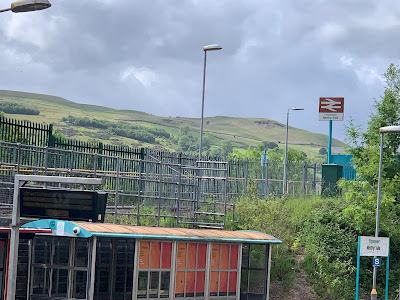 |
| This little train station was our gateway to Aberfan |
 |
| Kids killed in school by the slide |
 |
| Age 8 |
 |
| Someone said 10% of Welsh are named Jones |
 |
| Some have their street address |
 |
| The Aberfan Cemetery Gate |
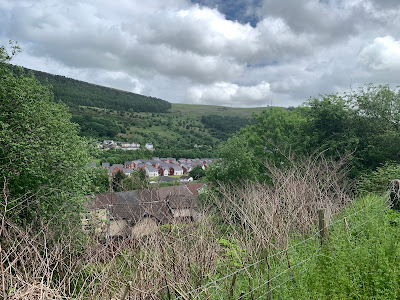 |
| We walked the path from school to cemetery. Looking south into town. |
 |
| This could be Tamaqua - Coaldale - Mahanoy City. It is Aberfan. |
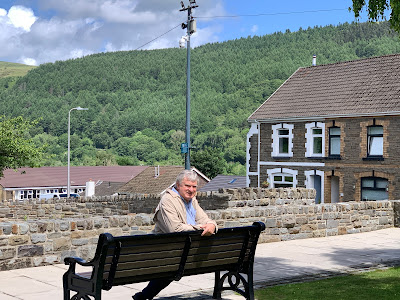 |
| I am sitting in the school - could have been looking out from my desk to the mountain. |
 |
| The queen visits often |
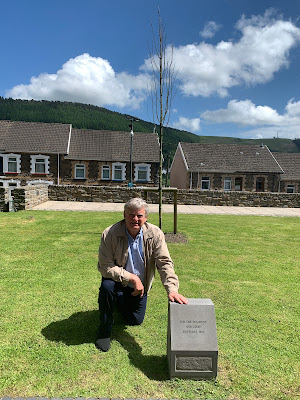 |
| Looking south inside the school. |
 |
| 55 years ago it happened. |
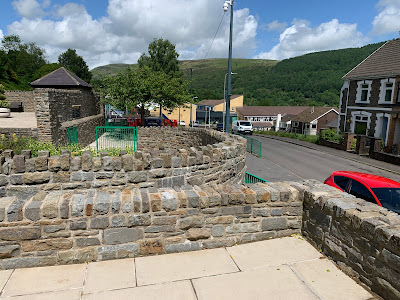 |
| The school's front door - the new modern community center - paid by world donations. |
 |
| Just across the street from school front door. |
 |
| South Africa donor. |
 |
| School memorial garden. |
 |
| School front wall. |
 |
| Moy Street looking west - school on right. |
 |
| We ate lunch here. Library. Pool. |
 |
| Moy Street - school |
 |
| Pantglas Junior School |
 |
| Moy Street |
 |
| Aberfan Pub - was closed. |
 |
| This church was used as a morgue |
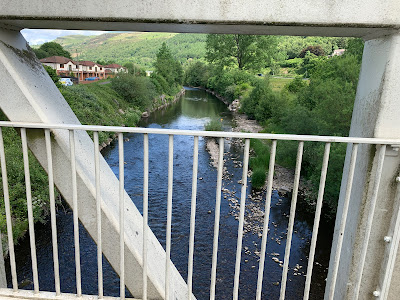 |
| Taff River to Cardiff. They used canal boats to haul coal too. |
 |
| Just a short 20 miles commute to the city |
 |
| Foot bridge across the Taff River |
 |
| Check out the unusual roof slant |
 |
| Our train stop |
 |
| Cardiff Central Train Station |





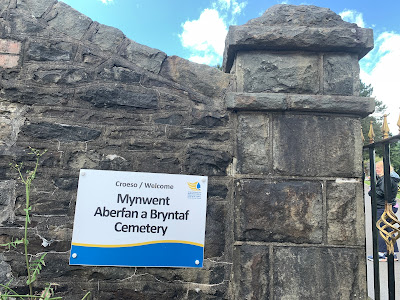
1 comment:
I do not recall hearing about this disaster. I was a Junior at FSU when this occurred. A stunning story. Smithsonian Magazine has an excellent story on the disaster. https://www.smithsonianmag.com/history/true-story-aberfan-disaster-featured-crown-180973565/
Post a Comment